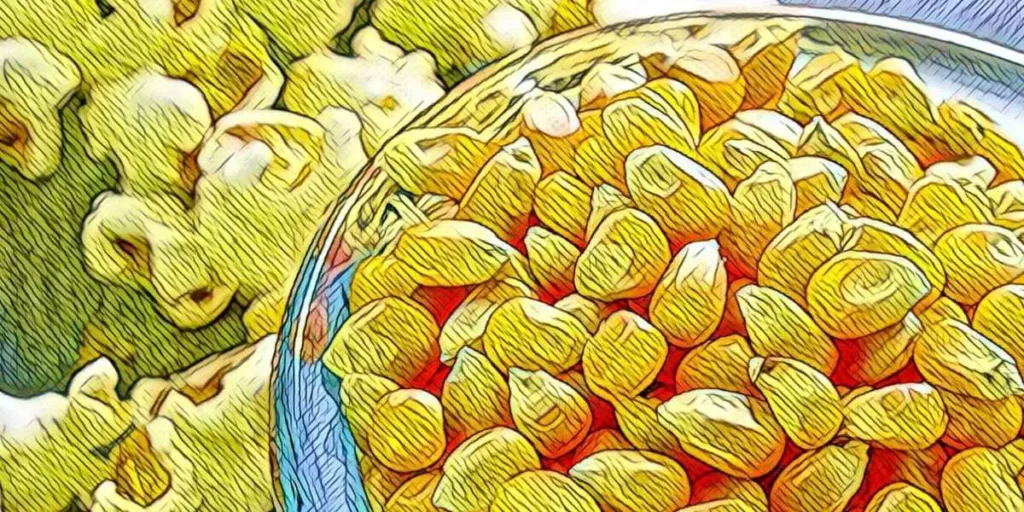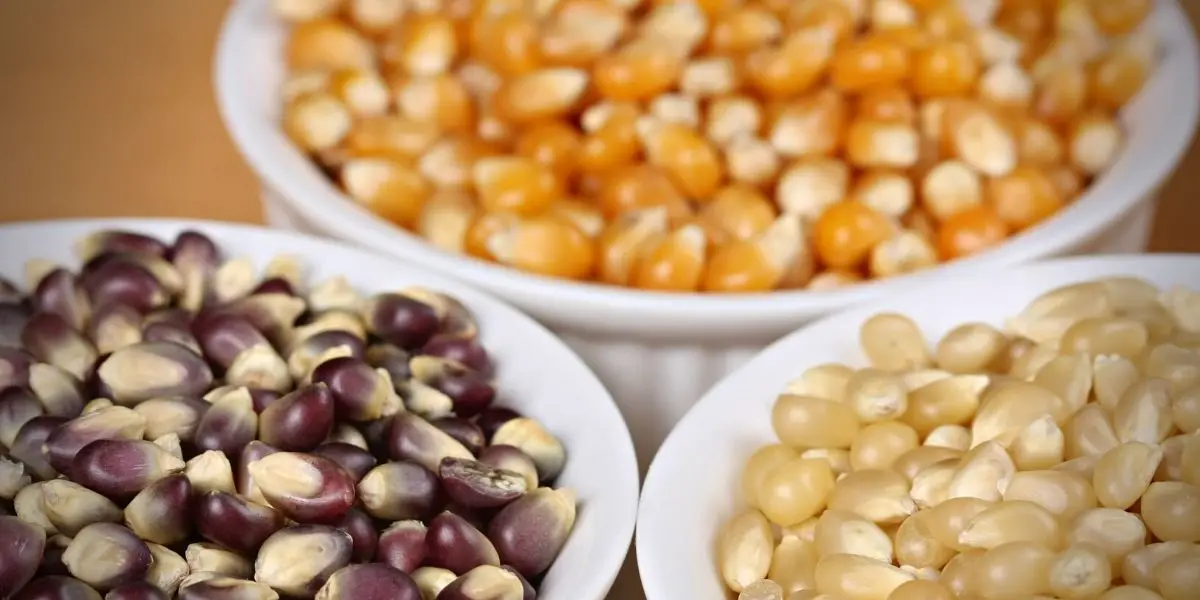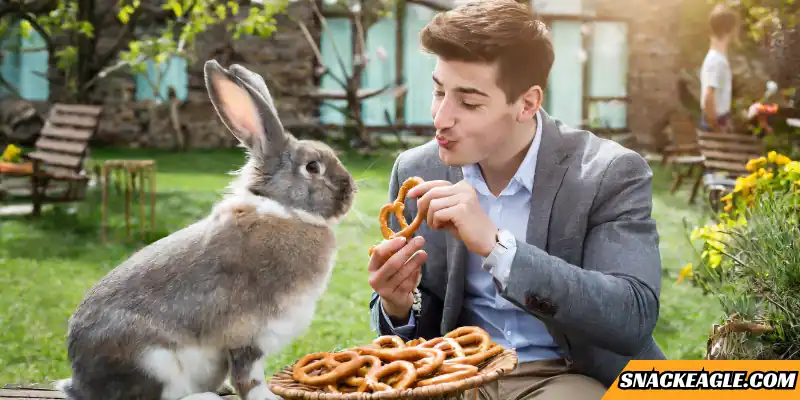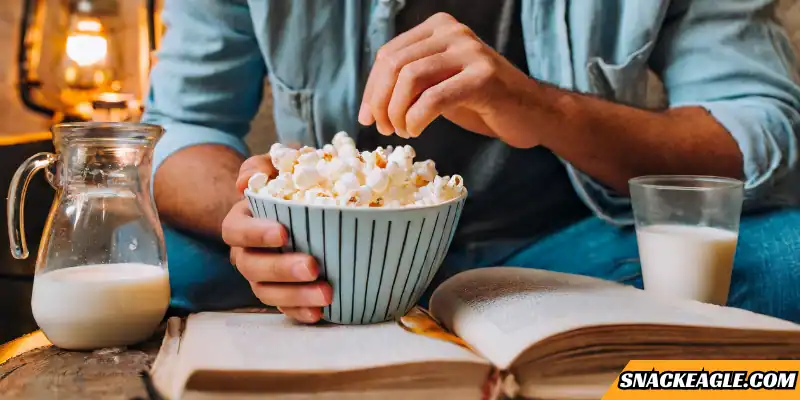Do you love popcorn? What about those unpopped kernels that always seem to end up at the bottom of the bag? This write-up will dive into all of your popcorn kernel-related queries.
We’ll discuss what is a popcorn kernel? And where do they come from? And how do they become yummy popcorn?
So sit back and prepare to learn all there is to know about popcorn kernels.
What is a Popcorn Kernel?
A popcorn kernel is the seed of corn called Zea Mays Everta. It is hard, dry, and yellow, red, white, or blue. It comprises a plant embryo, endosperm, the starchy tissue that nourishes the embryo, and a tough exterior covering known as the husk.
Popcorn kernels are qualified as seeds because they contain an embryo. Therefore, they can reproduce at the right temperature and moisture content. Each seed of popcorn has three main layers that contribute to its ability to pop. They include:
Each kernel holds a unique droplet of water that triggers it to “pop.” When heat is applied to the dried kernels, the water droplet becomes vapor, and pressure rises in the kernels’ starch, erupting into a fuffy white popcorn balloon.
From a kernel to luscious popcorn – it all comes down to the physical and chemical composition of the kernel itself.
Each popcorn kernel, you see, has an impenetrable outer shell that protects moisture. When this shell comes into contact with hot air or oil, the water within the kernel expands and generates steam, causing the kernel to burst.
So, it is vital to use the right amount of oil when making popcorn – too much, and the kernels won’t be able to pop; too little, and it will be dry and crumbly. Whether you like your popcorn crunchy or soft, remember that it all starts with a simple kernel of corn. Who knew science could be so delicious?
Where Does a Popcorn Kernel Come From?
Where do popcorn kernels come from? Popcorn kernels originated with the Aztecs in the Valley of Mexico, Native America. 9000 years ago, the Aztecs grew popcorn maize (teosinte, a wild grass).
A recent study unearthed 6700-year-old popcorn kernels on corncobs in Peru. Zea mays everta is the scientific term for popcorn kernels yielding pearl-shaped, velvety popcorn kernels and longer rice popcorn kernels in red, pink, blue, and yellow variants.
The popcorn kernel is from the maize plant, a teosinte wild grass family member. The maize plant has wide varieties, and one of those varieties is popcorn or Zea Mays Evetra. All early corn crops in Mexico were popcorn, quite a few varieties that sprout popcorn kernels like high fiber mini pressure cookers.
A Bubbly Popcorn Kernel from Ancient Times – A Brief History of Popcorn

Recently, 6,700-year-old popcorn was discovered in Peru. The kernels were perfectly maintained, and they could still pop.
If you look at an exploded kernel under a microscope, you can see the air pockets generated by the expanding steam, which is why it seems like a fluffy bubble. Mexico is credited with developing popcorn in 1523, but the Aztecs already enjoyed this snack long before.
It wasn’t until the early 1800s that popcorn started to gain popularity in the United States.
This is due to several factors, including botanical and environmental conditions. The Midwest’s lengthy, hot summers enable agricultural growth.
Totopoca means “Popping Kernels”
Popcorn, it turns out, is high in antioxidant phenolic acids and has been tied to a lower risk of cardiovascular issues. Popcorn aided in the establishment of the Aztec Empire. Totopoca was the Aztec name for the sound of multiple kernels bursting.
Several Popcorn Kernel Varieties Exist
The most popular variety is Zea mays everta, which is a small, flinty type of corn. This variety produces both pearl and rice popcorn. Rice popcorn kernels are longer than regular pearl kernels, and their grains are more petite; several hues appear from red to yellow.
How do Popcorn Kernels Pop?
For popcorn kernels to pop, they require water found in the starchy layer of the endosperm and heat. During heating up on their own or with oil, there is a high-pressure buildup during the cooking. This causes an explosion, giving fluffy and airy balls of popcorn.
Due to the hard nature of the seed coat, the water heated up in the endosperm cannot escape. As it turns to steam, it softens the surrounding starchy environment and the steam particles move faster.
When the amount of steam goes up, the speed of the water particles goes up. Therefore, an increase in pressure is exerted. The pressure from inwards supersedes that exacted by the seed coat and it bursts, producing cooked puffed products.
The final color of the popcorn is dependent on the strain and characteristics of the corn used. This process is quite fascinating and, according to the National Agricultural Library, it has inspired the folklore of Native Americans.
To find out more about the origins of popcorn, check our article: The Culture that Introduced Popcorn to the World.
Is a Popcorn Kernel the Same as Corn?
Although popcorn kernels are a species of maize, not all corn is popcorn.
A popcorn kernel is a flinty kind of maize that pops when cooked. The protein membrane causes the popping sound in the kernel to expand when heated and contract when cooled.
Popcorn kernels usually are orange-yellow, while sweetcorn kernels are white or unevenly colored. So, although all corn is Zea mays, not all of it is suitable for making popcorn.
Growing and harvesting circumstances may impact corn’s starch and water levels, affecting Zea Mays Everta kernels for popping.
A few differences between popcorn kernel and corn:
Field corn (dent corn), like dried dented corn kernels, is a different form of corn from popcorn and sweet corn. Starch and syrup may be produced from this corn, which is often used as animal feed.
In addition, there are other differences, including:
Procedure of Harvesting
Corn harvesting happens before, during, and after maturity. It depends on the type of corn. However, popcorn can only be harvested after the plant browns. This is done to achieve an optimum moisture content of 25% or less.
The Appearance of the Seed
After harvesting, popcorn has a bold and vibrant orange color with a yellow hue. On the other hand, other types of corn predominantly maintain a deep yellow or white appearance. Furthermore, popcorn has a tough exterior, while other types of corn tend to be softer.
The Method of Preparation and Consumption
Some types of regular corn, such as sweet corn, are consumable while on the cob or after grilling. However, popcorn cannot be digested in this form and needs to be popped. Consuming unpopped kernels is a choking hazard and can damage teeth, especially in children.
For more information on digesting popcorn, check our article.
The End Products They Make
Regular corn can undergo processing into other products. These include corn oil, corn meal, corn starch, and syrups. However, popcorn kernels can only make popcorn.
The Difference in Calories
It takes a small number of kernels to produce a satisfying bowl of popcorn for a small number of calories. However, regular corn offers more calories for the same serving, depending on the form it is in.
Need some ideas for old popcorn kernels?
Is a Popcorn Kernel a Seed?
A popcorn kernel is a seed that includes an embryo and a seed coat. The embryo will grow into the popcorn plant. The seed coat has a hard outer shell that protects the embryo.
Popcorn seeds are developed for specific traits, such as stalk strength, grain color, and popping ability.
Popcorn has certain genetic features that make it unique from other types of corn. For example, pollen from a plant’s male tassel is transferred to its female silk to fertilize the plant. This process is called cross-pollination. Inbreeding separates genes, allowing breeders to locate and maintain healthy seeds.
Cross-breeding is the process of choosing desired qualities from two different sources. The plant selection process hasn’t altered in eight years, and crossing two popcorn cousins creates improved varieties of popcorn.
Is Popcorn Classified as Corn?
The scientific answer is yes, but it is a unique form of corn. Popcorn is the only type of corn that pops, and its distinctive design is the secret to its success.
Popcorn kernels have a tough, nonporous outer shell (the seed coat) with a tiny surface area. Sweetcorn variants lack the surface area surrounding each grain to turn into popped corn.
Furthermore, the main kernel as a whole must have the proper level of moisture. While all these conditions must be met for the popcorn to pop, once popped, the kernel’s starch turns into a polymer full of air pockets. This makes popcorn light and fluffy, and we all know how much fun that is to eat!
Are Popcorn Kernels Alive?
Yes, popcorn kernels are alive but restrained until gestation conditions are realized. They need water to sprout and remain dormant until they get it. Cooking kills popcorn kernels. This denatures their proteins and effectively detonates them. So ponder this the next occasion you munch popcorn: you’re ingesting exploded organisms.
Popcorn is alive because when it is burst, it makes a bang. When inactivated popcorn is heated, it springs to fruition. The kernels remain active as the cob grows and are still seedlings when plucked.
Water is cells of living things, even popcorn kernels; water boils and compresses when heated.
Popcorn kernels are a mode of reproduction connected to the maize plant; thus, popcorn is thriving well. The ear dies when detached from the plant as it loses more fluids than it absorbs and lacks nourishment from the plant’s vascular structure.
Can you Grow Popcorn Kernels?
Yes, you can grow popcorn kernels by planting them in a sunlit portion of your garden after the frost has passed and the soil is warm.
You will need to plant them 10-12 inches apart in rows 25 inches apart. You should fertilize and compost before planting and mulch after planting to keep the kernels wet and allow for faster germination.
Quick Popcorn Growing Tips
Growing popcorn is a fun and easy way to get fresh popcorn from your backyard. Here are some quick tips for growing popcorn:
Popcorn takes a bit longer to germinate than sweet corn, and most types need 90 to 120 days to mature. If you enjoy the colors Carousel and Glass Gem, or the ancient yellow Heirloom popcorn, there are several fascinating varieties of popcorn.
Once the corn is dry on the stalk, you can harvest it, husk it, and keep it in a dry area with top-notch ventilation. With some care and attention, you’ll enjoy fresh popcorn in no time.
Can you Plant Corn Kernels to Grow Corn?
Yes, you can grow corn from corn kernels, but you’ll need a bag of popcorn from a seed vendor and a different kernel for sweetcorn.
To grow from a corn cob, dry the corn cob before planting. But, for the kernels, pat dry them and place them on a wet paper towel; carefully insert them into a sealed bag.
Keep the bag out of the sun between 65 and 75 degrees Fahrenheit. Inspect the kernel bag in 7-10 days. Just note soggy kernels may mold in storage, so dry corn before seeding.
Can all Corn be Turned into Popcorn?
No, all corn cannot be turned into popcorn; all popcorn is corn, but not all corn is popcorn.
Popcorn, like other forms of corn, is a cereal grain that evolved from tall grasses. Zea mays everta is the one and only corn that pops.
Dent corn, used for animal feed and to make cornmeal, also can’t pop because its kernels are too hard. On the other hand, Flint corn has hard kernels like dent corn but is smaller and less starchy, making it ideal for popping.
Are Popcorn Kernels Seeds?
Yes, popcorn kernels are seeds. They are a type of corn kernel that has a hard, moisture-resistant outer shell, which helps to keep the kernel’s moisture and nutrients intact.
When heated, the moisture inside the kernel turns to steam, causing the kernel to burst open and turn into fluffy, tasty popcorn.
FAQs What is a Popcorn Kernel
What is a popcorn kernel?
A popcorn kernel is the seed of corn called Zea Mays Everta. It comprises a plant embryo, endosperm, and a tough exterior covering known as the husk. It holds a unique droplet of water that triggers it to “pop” when heat is applied.
Where do popcorn kernels come from?
Popcorn kernels originated with the Aztecs in the Valley of Mexico, Native America, where they grew popcorn maize, a wild grass known as teosinte.
Is a popcorn kernel the same as corn?
Although popcorn kernels are a species of maize, not all corn is popcorn. A popcorn kernel is a flinty kind of maize that pops when cooked, while other corn varieties have different characteristics.
Can you grow popcorn kernels?
Yes, popcorn kernels can be grown by planting them in a sunlit portion of your garden after the frost has passed and the soil is warm. They need proper care, including watering, fertilizing, and mulching.
Can all corn be turned into popcorn?
No, all corn cannot be turned into popcorn; all popcorn is corn, but not all corn is popcorn. Only Zea mays everta, a particular type of corn, pops.
Are popcorn kernels seeds?
Yes, popcorn kernels are seeds. They are a type of corn kernel that has a hard, moisture-resistant outer shell, which helps to keep the kernel’s moisture and nutrients intact.
Can you grow corn from corn kernels?
Yes, you can grow corn from corn kernels, but for popcorn, you’ll need a bag of popcorn from a seed vendor. The growing process requires care, including proper drying, planting, and temperature control.
What makes popcorn pop?
Popcorn pops due to the moisture within the kernel. When heated, this moisture turns into steam, causing pressure build-up. The kernel’s hard shell eventually can’t withstand this pressure and bursts, causing the popcorn to pop.
Why doesn’t every kernel in a bag of popcorn pop?
Not all kernels pop because some may not have enough moisture to create the steam needed for popping. Others may have tiny holes in their shell, allowing steam to escape before the pressure can build up.
What is the ideal oil quantity for making popcorn?
The ideal oil quantity is such that it lightly coats the kernels without drowning them. Too much oil can prevent the kernels from popping, and too little can result in dry and crumbly popcorn.
Can I plant popcorn kernels from a store-bought bag?
Yes, you can potentially grow corn plants from store-bought popcorn kernels. However, it’s important to note that these kernels are often processed for popping, not for planting, so their germination rate might be lower.
What are some popular popcorn kernel varieties?
Zea mays everta is the most popular variety. This type of corn produces both pearl and rice popcorn. Rice popcorn kernels are longer than regular pearl kernels, and their grains are more petite.
Why are popcorn kernels hard?
Popcorn kernels are hard because they have a strong, moisture-resistant outer shell known as the pericarp. This shell helps keep the kernel’s moisture and nutrients intact.
Are popcorn kernels alive?
Yes, popcorn kernels are alive but dormant until germination conditions are met. They contain an embryo which can sprout under the right conditions.
How long does it take to grow popcorn from a kernel?
Popcorn takes a bit longer to germinate than sweet corn, and most types need 90 to 120 days to mature.
What is a Popcorn Kernel Final Thoughts 💭
In conclusion, popcorn kernels are small, hard-shelled seeds that come from a special type of corn plant. When heated, the moisture inside the kernel turns to steam, causing the kernel to burst open and turn into fluffy, tasty popcorn.
Popcorn has been a beloved snack food for centuries, and its popularity continues to grow today. Understanding the science behind popcorn kernels can help you appreciate this delicious treat even more. Whether you prefer your popcorn plain or flavored, knowing what a popcorn kernel is and how it works can make your next movie night or snack break all the more enjoyable.
Also, remember to read our various blog entries for additional insight, like – The Ultimate Popcorn Guide
Sources
https://www.nal.usda.gov/
https://health.clevelandclinic.org/bad-child-swallows-popcorn-kernels/
https://www.acs.org/
https://www.medicalnewstoday.com/articles/324763#nutrition
https://www.exploratorium.edu/food/popping-popcorn




